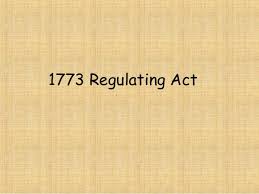A great step was taken in the Indian Legal History when the Supreme Court of Judicature was created at Calcutta under the Regulating Act of 1773
By 1773, East India Company of Britain was facing terrible financial straits. The company had a great significance to Britain as it was doing monopoly business in India and east and many influential people of Britain were attached with the company as shareholders. The company paid four hundred thousand pounds annually to British Government so that their monopoly was maintained. But the time came when the company was unable to meet its commitments to the government.
The conditions that persisted on the region of Bengal, Bihar and Orissa reflected the irresponsibility of the East India Company since it acquired the Diwani and the Nizamat. After these incidences British Parliament was convinced of the incompetence of the Company in any given circumstances and settled to undertake the Regulating Act.
• Salient features of the regulating act 1773
The Regulating Act described fully as an “Act for establishing certain regulations for the better management of the affairs of the East India Company as well in India as in Europe.” The features of this act were
1. Election for directors
The term of directors was increased from one year to four years and provision was made for electing one fourth of the directors every year in rotation. This was done to secure continuity in the direction of the company’s affairs and strengthening the position of the directors at the mercy of the shareholders who could thus always have their say.
To prevent power from being easily purchased by the company’s servants, voting power of the shareholders were restricted to those who held stock worth 1000 Pounds or more in the company. Small shareholders were thus deprived of their voting rights in the hope that is would result in improving the quality of shareholders, and accordingly, of the directors.
2. Control over correspondence
The Act tightened the control of the British Government over the Company in several ways. Thus, the directors were required to lay before the treasury all correspondence from India relating to revenues, and before a Secretary of State everything dealing with the civil and military affairs of the Government in India.
3. Appointment of governor-general and council
The Act reorganized the structure of the Calcutta government. It appointed a Governor General and a Council of four and vested in them “the whole civil and military government” of the Calcutta Presidency. Warren Hastings was appointed as the first Governor-General. The decisions in the council meeting were to be made by a majority of votes. The Governor-General had only one vote and a casting vote in case of a tie in the Council. He had no power to override the majority in the Council which could, as a result, defeat any of his policies. This system of one vote and no overriding authority was changed under Cornwallis changes.
4. Bombay and madras under the control of governor-general
A significant change was made in this system by the Regulating Act. It put the Presidencies of Madras and Bombay under the superintendence and control of the Calcutta Presidency in matters of war and peace. This however was subjected to two exceptions
I. The subordinate Presidencies could commence war or negotiate peace without the consent of the Calcutta Presidency if there were such imminent necessity as would render postponement of war dangerous pending arrival of orders from Calcutta.
II. Or if the Presidencies received orders directly from the Court of Directors. The subordinate Presidencies were required to transmit regularly to the Governor-General information regarding all transactions relating to the government, revenues or interests of the Company
5. Creation of the Supreme Court at Calcutta
An important innovation made by the Regulating Act was the creation of the Supreme Court at Calcutta superseding the judicial system prevalent there under the Charted of 1753. The act empowered the Crown to establish the Supreme Court at Calcutta through a royal charter Fort William. King George III issued a charter on March 26, 1774, which established a supreme court of Calcutta. It was a crown’s court. The court of request were however, allowed to continue. The governor general, members of the council and the judges of the Supreme Court were appointed as justices of Peace and were empowered to hold Quarter session for administering criminal justice. Sir Elijah Impey was appointed as the first chief justice of Supreme Court at Calcutta. It took the place of the former Mayor’s Court with more elaborate machinery. The Court was constituted of a Chief Justice and three puisine judges appointed by the King from barristers of at least five years experience. The authority of these judges was like those of King’s Bench in England. The admission of attorneys and advocates into the Supreme Court lay in their hands. The salary of the Chief Justice was fixed at 8000 sterling a year, and of three puisine judges 6000 sterling each. Engaging in commercial pursuits and receiving presents, which were common practices among the company servants of the time, were strictly forbidden. It had the functions of a Court of Equity according to the rules of the English High Court of Chancery.
It was also a Court of Oyer and Terminer and Gaol Delivery for Calcutta and subordinate factories. As a superior court it had the jurisdiction to superintend the Court of Requests and the Court of Quarter Sessions and the magistrates of the courts. The Supreme Court was also a Court of Admiralty for Bengal, Bihar and Orissa and authorized to punish treason, murders, piracies, etc committed on the high seas within its jurisdiction. The court had jurisdiction over all British subjects resident in Bengal, Bihar and Orissa. But the Regulating Act and Royal Charter defined the jurisdiction of the court in vague terms.
The Regulating Act described fully as an “Act for establishing certain regulations for the better management of the affairs of the East India Company as well in India as in Europe.” The features of this act were
- Election for directors
The term of directors was increased from one year to four years and provision was made for electing one fourth of the directors every year in rotation. This was done to secure continuity in the direction of the company’s affairs and strengthening the position of the directors at the mercy of the shareholders who could thus always have their say.
To prevent power from being easily purchased by the company’s servants, voting power of the shareholders were restricted to those who held stock worth 1000 Pounds or more in the company. Small shareholders were thus deprived of their voting rights in the hope that is would result in improving the quality of shareholders, and accordingly, of the directors.
- Control over correspondence
The Act tightened the control of the British Government over the Company in several ways. Thus, the directors were required to lay before the treasury all correspondence from India relating to revenues, and before a Secretary of State everything dealing with the civil and military affairs of the Government in India.
- Appointment of governor-general and council
The Act reorganized the structure of the Calcutta government. It appointed a Governor General and a Council of four and vested in them “the whole civil and military government” of the Calcutta Presidency. Warren Hastings was appointed as the first Governor-General. The decisions in the council meeting were to be made by a majority of votes. The Governor-General had only one vote and a casting vote in case of a tie in the Council. He had no power to override the majority in the Council which could, as a result, defeat any of his policies. This system of one vote and no overriding authority was changed under Cornwallis changes.
- Bombay and madras under the control of governor-general
A significant change was made in this system by the Regulating Act. It put the Presidencies of Madras and Bombay under the superintendence and control of the Calcutta Presidency in matters of war and peace. This however was subjected to two exceptions
- The subordinate Presidencies could commence war or negotiate peace without the consent of the Calcutta Presidency if there were such imminent necessity as would render postponement of war dangerous pending arrival of orders from Calcutta.
- Or if the Presidencies received orders directly from the Court of Directors. The subordinate Presidencies were required to transmit regularly to the Governor-General information regarding all transactions relating to the government, revenues or interests of the Company
- Creation of the Supreme Court at Calcutta
An important innovation made by the Regulating Act was the creation of the Supreme Court at Calcutta superseding the judicial system prevalent there under the Charted of 1753. The act empowered the Crown to establish the Supreme Court at Calcutta through a royal charter Fort William. King George III issued a charter on March 26, 1774, which established a supreme court of Calcutta. It was a crown’s court. The court of request were however, allowed to continue. The governor general, members of the council and the judges of the Supreme Court were appointed as justices of Peace and were empowered to hold Quarter session for administering criminal justice. Sir Elijah Impey was appointed as the first chief justice of Supreme Court at Calcutta. It took the place of the former Mayor’s Court with more elaborate machinery. The Court was constituted of a Chief Justice and three puisine judges appointed by the King from barristers of at least five years experience. The authority of these judges was like those of King’s Bench in England. The admission of attorneys and advocates into the Supreme Court lay in their hands. The salary of the Chief Justice was fixed at 8000 sterling a year, and of three puisine judges 6000 sterling each. Engaging in commercial pursuits and receiving presents, which were common practices among the company servants of the time, were strictly forbidden. It had the functions of a Court of Equity according to the rules of the English High Court of Chancery.
It was also a Court of Oyer and Terminer and Gaol Delivery for Calcutta and subordinate factories. As a superior court it had the jurisdiction to superintend the Court of Requests and the Court of Quarter Sessions and the magistrates of the courts. The Supreme Court was also a Court of Admiralty for Bengal, Bihar and Orissa and authorized to punish treason, murders, piracies, etc committed on the high seas within its jurisdiction. The court had jurisdiction over all British subjects resident in Bengal, Bihar and Orissa. But the Regulating Act and Royal Charter defined the jurisdiction of the court in vague terms.





23 Comments. Leave new
Good attempt at elucidating the Regulation Act of 1773.
Good effort!
good effort 🙂
Nice article.
Good work!
Very informative article and I really like the way how you have presented the article in the pointers
Informative
Very informative and well researched.
good work… nice article!
good work but very very long article…
well explained!
Well presented and good work 🙂 explained in a very systematic manner 🙂
What an informative article
Interesting!
nice 🙂
Great efforts
Very well written, indeed a great job
Perfectly described. Great work!
Thanks for such an informative article. 🙂
Nice work though a bit long
A very good article written
So informative, it was very interesting to read!!
Thanks Vishakha 🙂
That’s a well researched and perfectly articulated work!